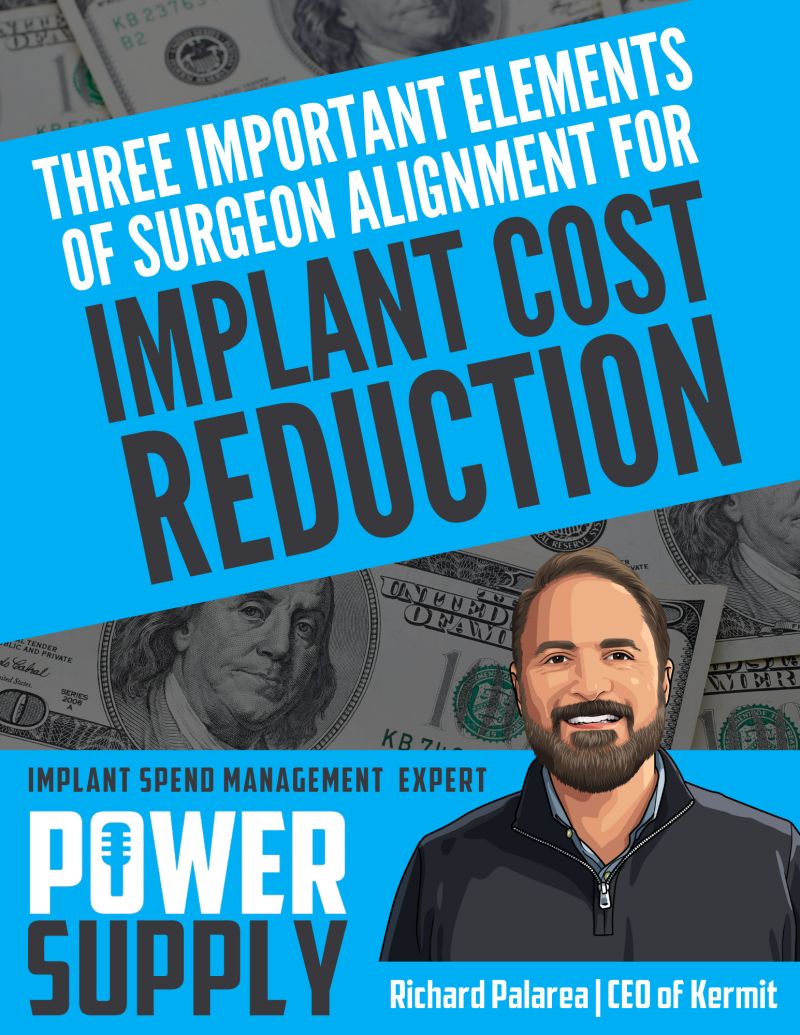This post is an accompaniment to Power Supply's Expert Series TM where Kermit CEO Rich Palarea serves as the Implant Spend Management Expert. The original Power Supply Expert Series post can be found on Power Supply's LinkedIn.
Early in the founding of Kermit, I found myself presenting an overview of a bid and negotiation project to a group of surgeons at a client hospital. At the close of the meeting, I was approached by one of the more mature surgeons from the group. I later learned that this physician had performed his share of knee and hip replacement surgeries, but had also been asked by his executive leadership and supply chain to rescue a previous bid and negotiation initiative with implant vendors that were going south and fast on more than one occasion.
While the cohort of doctors quickly cleared the room after my talk to perform their scheduled surgeries, this physician began approaching me. As he made his way over, he reached for his eyeglasses and pulled them from his face, as if to punctuate the importance of what he was about to share with me. And while Kermit had enjoyed success in its first few projects, we were relatively new and still pioneering the successful and widely adopted approach we use today.
Our eyes met and he arrived toe-to-toe with me, I was already feeling outmatched. I was hoping he was not about to poke holes in my approach and scuttle the project before it got underway, but I was ready to take whatever he had for me.
As he took a breath to release the first highly anticipated words, the countenance of his face changed from all-business to a cheerful, kinder, and gentler caregiver. “Thank you”, he said, as he extended his hand for a welcoming handshake. “You’re welcome!” immediately came rushing out, but quickly followed with an equally kind, “I’ll always take a thank you, but what did I do?”
He began to take me through the last few years of price negotiations performed by his hospital. Well-meaning professionals had set about to do their jobs. In their wisdom, they determined they would not “bother” the surgeons unless, and only until, they absolutely needed their help. After all, surgeons were busy caring for patients and it was not their area to negotiate supply prices. He recounted how he had been called at the eleventh hour to speak with his implant rep and the supplier’s management to help turn the tide on the price discussions. The disdain on his face told me all I needed to know. He felt put upon to fix another’s mess, yet not valued enough to be part of the strategy from the beginning.
The doctor explained the reason for his gracious gesture was for bringing him and his colleagues into the project at this early stage. But I already knew a few things that would be key to having a successful implant bid and negotiation project from our earlier wins. We had committed early on that surgeon alignment – the transparent sharing of the project approach and objectives – would be required to have the support of the surgeon community.
Come One and Come All
Before any initiative kicks off, determine the surgeons who should be involved. While most hospitals already do this, they make the common mistake of only inviting their top surgeons as deemed by volume or revenue, or even those who wield the most influence. Instead, hospitals should invite the entire cohort. Some will participate, others may not, but your openness and willingness to include everyone will set the tone.
Invite Them to Participate from the Beginning of the Project
Every sports team wants its best player on the field on opening day, and you should want your surgeons involved from the very beginning of the project. Since your surgeons will play such a critical role in this initiative, they should be a part of it from the beginning. Let them know your plan, your “why,” and what they can do to make it successful. Address their concerns head-on and build a formidable team!
Share it All and Solicit Feedback
As the process transpires, you may wonder what you can comfortably share with your surgeons. The answer: everything! After all, as key players who have daily facetime with vendor representatives, your surgeons need to know the latest updates. We cannot forget that they are dealing with their reps daily, and being up to date with the status of the project will go a long way in equipping them for impromptu and potentially ambushing discussions. Also, you must be open to feedback from your key players. They are a valuable source of information with hands-on experience.
Providing your entire team from supply chain to physicians with the visibility to projects you are encouraging an environment of collaboration. Having siloed teams with no access to each other’s processes and involvement in crucial savings initiatives creates a disjointed plan that vendors can poke holes in and use to their advantage, Kermit’s solution of full involvement on all ends creates a united front that is impenetrable to vendors and their sales tactics.

